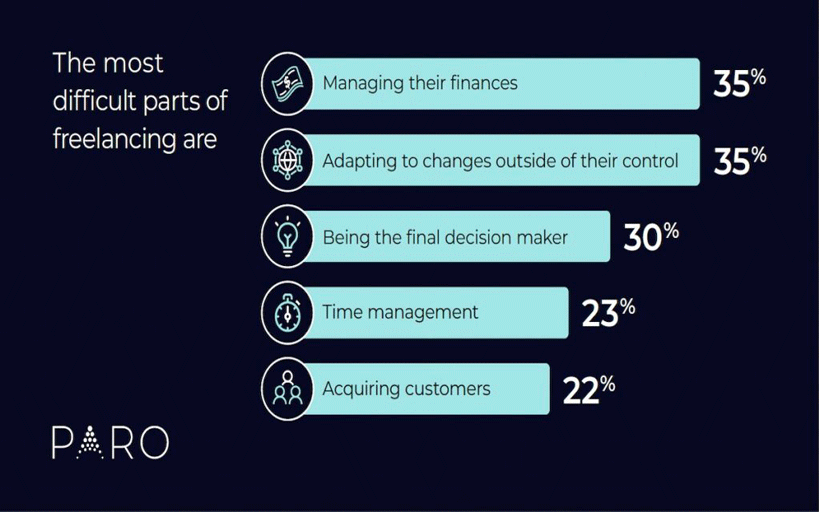From Gig to Growth: Turning Freelance Projects into Full-Time Opportunities
Freelancing can feel like a constant hustle – exciting one week and uncertain the next. But with the right approach, you can turn short-term gigs into a sustainable, full-time freelance career. That means building lasting client partnerships, standing out in your niche, and treating your freelance work like a growing business. In this article, we’ll cover proven strategies for cultivating long-term opportunities: fostering client relationships, strengthening your brand, upselling services, managing money smartly, and putting systems in place to scale. Read on for actionable steps and real-world examples to motivate you to turn your next gig into your next big opportunity.
Cultivate Long-Term Client Partnerships
Strong relationships are the heart of a stable freelance business. Deliver high-quality work on time and communicate proactively. Follow up with clients, ask about their evolving needs, and show genuine interest in their goals. For example, one Upwork freelancer went beyond delivering content by creating extra graphics free of charge; the client was so impressed that he hired a dedicated content team member and eventually brought the freelancer on as a full-time staff writer. Key relationship-building strategies:
- Overdeliver and communicate. Always aim to exceed expectations. Keep clients updated on progress and ask thoughtful questions. As one freelance designer noted, “Provide value to your existing clients on an ongoing basis and offer it to them. Doing so will completely transform your freelance business”.
- Stay in touch and plan ahead. Don’t disappear when a project ends. Schedule regular check-ins, even quick emails, to ask about upcoming projects or new challenges. One content writer reports maintaining six retainer clients (avg. 2-year relationships) by being “super prompt in all communications” and asking each month about likely workloads.
- Identify ideal clients. Not every gig is worth scaling. Look for clients who value your expertise and are open to deeper collaboration. A Paro freelance expert advises choosing clients who are “open and willing to trust your expertise and grow with you”.
- Secure retainers or recurring contracts. Instead of one-off projects, propose ongoing agreements. Matt Olpinski, a UI/UX freelancer, emphasizes that retainer agreements often get renewed when you do great work and communicate well. Consistency not only stabilizes your income, it turns clients into long-term partners.
By treating clients as partners and looking beyond the original scope, you can transform one-off gigs into repeat work or referrals. Always keep the conversation open about future work – often the same client who needed a one-time task may need your help again with something bigger.
Build a Strong Personal Brand & Presence
Standing out in a crowded market means positioning yourself as an expert. A strong personal brand and online presence attract higher-quality clients and long-term projects. Upwork calls this “thought leadership,” and notes that positioning yourself as a credible authority helps you charge higher rates and secure long-term work. In practical terms, this means defining what makes you unique (your niche, style or specialty) and consistently showcasing it.

Graphic: Key steps to become a recognized expert (build your brand, use social media, share content, network, upskill, and measure your strategy). To build your brand and visibility:
- Optimize your profiles and portfolio. Treat LinkedIn, Upwork, or your personal website as professional storefronts. Highlight your best work with case studies or testimonials and clearly state the services you offer. For example, freelancers often upgrade their LinkedIn headline and summary to mention specific industries or skills, so clients searching for those keywords can find them.
- Define your unique value proposition. Know what sets you apart (e.g. a designer who specializes in eco-friendly brands, or a writer fluent in tech jargon) and weave that into all your messaging. Being specific makes you memorable.
- Share expertise through content. Write blog posts, publish articles on Medium or LinkedIn, record videos or podcasts – whatever format suits you. By educating your audience, you demonstrate knowledge and keep your name top of mind. Thought leaders are often the first people clients think of for big projects.
- Leverage social media and networking. Stay active where your clients are. A regular presence on LinkedIn (posting updates, commenting in groups) or industry forums can attract opportunities. Networking at conferences or meetups also builds credibility. As Upwork advises, networking with industry professionals helps build your reputation and open doors.
Example: Upwork’s guide notes that experts earn more and get steady referrals. In fact, freelancers who brand themselves as specialists can often pick the best projects and negotiate retainer deals, because clients see them as trusted advisors.
Package and Upsell Your Services
Once you’ve delivered great work, look for ways to expand the engagement. Upselling (offering a premium version of your service) and cross-selling (offering related services) can deepen client relationships and stabilize income. A Paro expert compares it to car sales: you don’t just sell the basic model – you also offer add-ons like extra insurance or luxury features. For freelancers, that might mean:
- Offer upgraded packages. If you’re doing basic work, propose an enhanced plan. For instance, a copywriter might offer editing and publishing on top of writing, or a developer might bundle maintenance services with a website build. Make sure the extra service adds real value.
- Suggest related services. If you notice a need, pitch it. A Paro example: a freelancer writing blog posts offered to run the client’s social media as well, since content and social strategy often overlap.
- Propose retainer agreements. If a client’s work is ongoing or loosely defined, suggest a fixed monthly fee instead of per-project billing. Olpinski explains that a monthly retainer “leaves the scope of work and total project cost flexible for you and the client”. Clients appreciate predictable budgeting, and you get steady income.
- Highlight long-term value. When pitching upsells or retainers, emphasize the bigger picture. Remind clients that continuous collaboration means you stay aligned with their evolving goals. As one success tip says: “Retainer agreements often get renewed…with hard work and good communication”.
By expanding what you offer, you become a one-stop solution rather than a one-time contractor. For example, one marketer who started by creating ad graphics ended up being brought on as the client’s ongoing content partner, because he showed how his extra skills (Pinterest marketing) could grow the business. Always frame your upsells as win-win improvements for the client.
Manage Your Finances Like a Business
Financial discipline turns a gig economy lifestyle into a stable career. In fact, a survey found that “managing finances” was the most cited challenge for freelancers (35%). To gain control, treat your freelance work as an ongoing business: track, budget, and plan ahead. Key practices include:

Survey results: “Managing finances” is cited by 35% of freelancers as the toughest part of freelancing.
- Separate business and personal accounts. Use a dedicated checking account and credit card for all freelance income and expenses. This simplifies bookkeeping and makes tax time easier.
- Track income and budget wisely. Since monthly earnings vary, base your budget on an average monthly income. Save during high-earning months to cover slower periods. Keep detailed records of receipts and invoices.
- Pay yourself first. Decide on a fixed “salary” and transfer it from your business account every month. Many financial experts advise putting your pay aside before other expenses. This approach ensures you live within your means and treat your personal needs as a priority.
- Build an emergency fund. Aim to save 3–6 months’ worth of expenses. An emergency buffer protects you from income dips and unforeseen costs.
- Plan for taxes and retirement. Set aside a portion (commonly 20–30%) of each payment for quarterly taxes. Also contribute to retirement accounts (like an IRA or solo 401(k)) whenever you can. Remember, freelancers don’t have automatic withholdings, so you must proactively save.
- Monitor cash flow. Use simple spreadsheets or accounting apps to see your earnings vs. expenses. This helps you adjust pricing or workload before a cash crunch happens.
Staying on top of money matters removes stress and lets you focus on growing. As one freelance tax advisor notes, good financial habits (like clear records and budgeting) are the foundation of a successful freelance career.
Streamline and Scale Your Business
As your client base and income grow, adopt systems and processes so you don’t burn out. Work smarter as well as harder. Some ways to scale include:
- Automate and standardize processes. Use tools or templates for proposals, invoices, time tracking, or client follow-ups. Even simple checklists for onboarding new clients save mental energy. Automating repetitive tasks frees up time to take on more work or improve your skills.
- Collaborate with others. Partner with other freelancers or hire help. For example, network with professionals who have complementary skills (like a designer teaming up with a copywriter). This lets you offer bigger projects and prevents turning down gigs outside your expertise. Subcontractors or a virtual assistant can also handle admin tasks.
- Invest in continuous learning. The market changes rapidly. Stay competitive by upskilling or learning new tools. Accept projects that stretch you, attend industry conferences, or even bring on trainees/mentees. A fresh skillset means you can charge more and tackle higher-value jobs.
- Raise your rates strategically. As demand for your services increases, don’t hesitate to adjust pricing. Consider offering a retainer to long-term clients – it often allows a slight discount for them but more security (and free time) for you. For new clients, lean toward higher-paying projects that respect your worth.
- Develop passive income streams. Create digital products or ongoing services. This could be an online course, e-book, templates, or a paid newsletter related to your expertise. For instance, a graphic designer might sell stock illustrations or a marketing consultant might launch a subscription service. Passive offerings can significantly increase revenue without requiring more billable hours.
By setting up scalable systems, you transform from doing every task yourself to managing a small operation. This flexibility lets you take on bigger opportunities or even transition into your own boutique agency in the future. (Even Matt Olpinski eventually started a design company after building a freelance foundation.)
Conclusion: Take Action and Grow
Turning one-off gigs into stable, full-time opportunities is a journey, not a flip of a switch. It requires a mindset shift: see each client as a partnership, and each project as a stepping-stone to the next. The key takeaways are: deliver value consistently, build your expert brand, be proactive about selling additional services, manage your money with care, and put smart systems in place.
In short: focus on relationships first, then on reputation and organization. Check in with your clients – do they have more work you can do? Update your LinkedIn and portfolio today to reflect your best niche. Set up that accounting system or savings plan this week. Small actions compound: every retainer contract signed or positive testimonial earned makes your business more robust.
The freelance lifestyle offers immense freedom, but also responsibility. By applying these strategies, you can create the predictability and growth often associated with “full-time” roles—while staying your own boss. So pick one idea from above and start now. Your next gig can be the foundation for a thriving freelance career.









